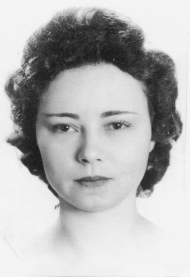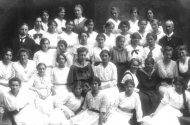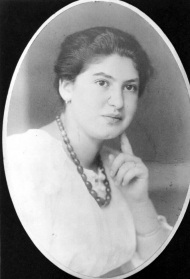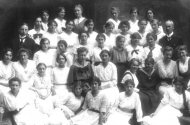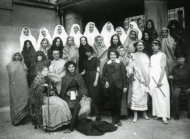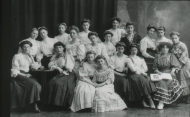|
|
|
|
|
|
|
|
|
|
|
|
|
|
|
|
|
|
|
|
|
|
|
|
|
|
|
|
|
|
|
|
|
|
|
|
|
|
|
|
|
|
|
|
|
|
|
|
|
|
|
|
|
|
|
|
|
|
|
|
|
|
|
|
|
|
||||||||||||||||||||||||||||||||||||||||||||||||||||||||||
|
|
Ilse Marx Born: 1907 in Buttenhausen. Father’s occupation: trader in Buttenhausen. Ilse’s father, Max Marx (b. 1874), worked as a cattle and horse trader in Buttenhausen, a small town in Württemberg. Ilse’s mother was Rosa, née Gruber (b. 1882 in Augsburg). Ilse’s aunt Lina Horn, née Gruber, was the mother of Berta Horn. Ilse’s uncle Jacob Gruber was married to Ernestine Obernbreit. Ilse had two sisters, Sittah (b. 1908) and Paula (b. 1910), and a brother, Werner (b. 1921). When the three girls were about 10–12 years old, they were sent to their maternal grandparents, Abraham and Mathilde Gruber, in Augsburg. There they should recieve a better education than could have been procured in Buttenhausen. Ilse attended Maria-Theresia-School from 1918 to 1920 in classes 1 and 2; perhaps she completed the fifth grade in 1923. Afterwards, she attended a business school (“Handelsschule”), as did her sisters. Having completed school, Ilse accepted an office position in Nuremberg in a furniture factory. Around 1927, she moved to Munich to her uncle Ludwig Gruber and his wife, Erna. The couple owned a tobacco store at Odeonsplatz. They had no children. Eventually Ilse would have inherited the business. During the “Night of Broken Glass” (“Kristallnacht”) in November 1938, the National Socialists destroyed the store. Two days later, Ludwig was arrested and sent to the Dachau concentration camp, where he perished on November 25. Erna Gruber fled to England in 1939. Ilse emigrated, via England, to the USA that year, as her three siblings had done before. In 1940, also her parents could emigrate via Italy to the USA. They both died in New York City, Max in 1963, Rosa in 1965. Ilse’s maternal grandmother, Mathilde Gruber, was deported from Munich to Terezin in June 1942. There she died in 1944 at age 84. |
In the USA, Ilse took part in various activities in the health care field. She never married. She changed her name to Jean I. Mar. After moving into a Jewish Assisted Living Facility, she became a contributing editor to its news letter. In Summer 2007, Ilse celebrated her 100th birthday. (Most of this information was supplied by Ilse’s brother, Werner L. Marx. It was taken from a letter he wrote to the project group in August 2007 as well as from his book on the former Jewish community of Buttenhausen.) Sources and further reading: The family tree of Ilse Marx, on JewishGen’s website The Family Tree of the Jewish People: www.jewishgen.org/gedcom (as of April 2007), and on The Abraham Marx Family Homepage by Eve Miriam Marx Lurie: http://familytreemaker.genealogy.com/users/l/u/r/Eve-M-Lurie/TREE/index.html (as of May 2008). Jean Mar (Ilse Marx), “Eyewitness to History. Germany in Two World Wars,” Kittay News 1/2002, pp. 1–3; also on this website (see below). Werner L. Marx, “Buttenhausen:” The History of a Former German-Jewish Community. Personal Recollections and Reflections, Baltimore, Maryland(published oneself), 1996. Letters and memories: Jean Mar (Ilse Marx), “Eyewitness to History,” 2002. |
|
|
Babette Mayer Born: 1901 in Fürth. Father’s occupation: businessman in Augsburg. Babette’s parents were Albert Mayer (b. 1868 in Kriegshaber, near Augsburg) and Charlotte, née Bergmann (b. 1870 in Langenzenn). Like Babette, also her older sister Jenny attended Maria-Theresia-School. The girls had another sister, Emilie (b. 1896), and a brother, Siegfried (b. 1899). Babette attended the “Municipal School for Daughters” (“Städtische Töchterschule”), which from 1914 on was called “Maria-Theresia-School”, from 1911 to 1917 in classes 1–6 and in 1918/19 in the “school for women”; presumably, she also attended the “school for women”, which normally took two years, in 1917/18. In July 1918, at the celebration of the end of the school year, Babette spoke the prologue and was mentioned by the young Bertolt Brecht in the ironical newspaper article he wrote about that feast. Babette’s father, Albert, died in Augsburg in 1932. The widowed Charlotte emigrated, together with her children Emilie, Siegfried and—presumably—Babette, to Rio de Janeiro, Brazil, in 1939. Presumably, Babette’s sister Jenny had been living there since her marriage in 1927. Babette’s mother, Charlotte, died in Rio de Janeiro in 1948. Sources and further reading: Gernot Römer, ed., “An meine Gemeinde in der Zerstreuung.” Die Rundbriefe des Augsburger Rabbiners Ernst Jacob 1941–1949, Augsburg, 2007, pp. 304–5, 307. Jürgen Hillesheim, Bertolt Brecht – Erste Liebe und Krieg, Augsburg, 2008 (with Brecht’s article, “Schlussfeier in der Maria-Theresia-Schule,” Augsburger Neueste Nachrichten, July 15, 1918). |
|
Jenny Mayer Born: 1897 in Nuremberg. Father’s occupation: businessman in Augsburg. Jenny’s parents were Albert Mayer (b. 1868 in Kriegshaber, near Augsburg) and Charlotte, née Bergmann (b. 1870 in Langenzenn). Like Jenny, also her younger sister Babette attended Maria-Theresia-School. The girls had another sister, Emilie (b. 1896), and a brother, Siegfried (b. 1899). Jenny attended the “Municipal School for Daughters” (“Städtische Töchterschule”), which later was to be called “Maria-Theresia-School”, from 1909 to 1913 in classes 2, 4, 5 and 6. In 1927, Jenny married Ignaz Erlanger from Rio de Janeiro, Brazil. Jenny’s father, Albert, died in Augsburg in 1932. The widowed Charlotte emigrated, together with her children Emilie, Siegfried and—presumably—Babette to Rio de Janeiro, where Jenny—presumably— had been living since her marriage. Charlotte and Jenny lived in Rio in the same house. Jenny’s mother, Charlotte, died in Rio de Janeiro in 1948. Source: Gernot Römer, ed., “An meine Gemeinde in der Zerstreuung.” Die Rundbriefe des Augsburger Rabbiners Ernst Jacob 1941–1949, Augsburg, 2007, pp. 304–5, 307. |
|
Johanna Mayer Born: 1906 in Augsburg. Father’s occupation: livestock dealer. Johanna’s parents were Samson Mayer (b. 1872 in Horkheim) and Ida, née Herrmann (b. 1879 in Hainsfarth). Johanna had two brothers, Ludwig (b. 1904) and Julius (b. 1907). Johanna attended Maria-Theresia-School in 1919/20 in class 4; perhaps she remained at the school until 1921/22 and completed the sixth grade in 1922. Later, she worked as a cashier at the shoe shop “Polatschek” in Maximilianstraße (see the biographies of Hedwig, Ida and Laura Polatschek). In 1936, Johanna (“Hansi”) married Fritz Ucko (b. 1906 in Stuttgart), who had worked in Augsburg for the department store “Brothers Landauer” until 1935. The couple first lived in Göppingen and emigrated to the USA in 1937. Johanna’s parents also emigrated to the USA. In Minneapolis, Minnesota, Johanna did homework as a seamstress, Fritz was a manager of the hardware store chain “Coast to Coast Stores”. Johanna’s father, Samson, died in Minneapolis in 1964, her mother, Ida, in New York in 1971. Johanna’s husband, Fritz, died in 1970. Johanna Ucko, née Mayer, died in Minneapolis in 2002. Source: Gernot Römer, ed., “An meine Gemeinde in der Zerstreuung.” Die Rundbriefe des Augsburger Rabbiners Ernst Jacob 1941–1949, Augsburg, 2007, pp. 306–7. |
|
|
Fanny Mendelsohn Born: 1897 in Munich. Father’s occupation: merchant. Home and store address: D 279 Philippine-Welser-Straße, Augsburg. Franziska (Fanny) and her brother Richard (b. 1904) were the children of Heinrich Mendelsohn (b. 1867 in Königsberg, Eastern Prussia) and Adele, née Grünhut (b. 1877 in Ronsperg, Bohemia). Heinrich owned a men’s wear store, “Mendelsohn Herren- & Knabenbekleidung”, at D 279 (today No. 16) Philippine-Welser-Straße. Fanny attended the “Municipal School for Daughters” (“Städtische Töchterschule”), which later was to be called “Maria-Theresia-School”, from 1909 to 1912 in classes 1–4 (she skipped class 2). After graduating from school, Fanny worked as Office Manager of her father’s shop. She married the businessman Hermann Frank (b. 1893), and in 1925 her daughter Hertha was born. At first, the Franks lived at her parents’ house before they moved to Bamberg in 1926. In 1928, Fanny and her daughter returned to her parents’ house in Augsburg while Hermann stayed in Bamberg. Fanny’s father died in 1933. In the next year, Fanny divorced, and Hermann Frank moved to Paris in September 1934. Fanny and her daughter, Hertha, emigrated to New York in June 1937. There Fanny changed her first name to Frances. At first she worked for c. three years as a housekeeper for a wealthy family, then in a factory for military boots during the war and finally, as an accountant in an office. Her brother, Richard, had already emigrated to South Africa in January 1937. In 1939, Fanny’s mother, Adele, joined him in Southern Rhodesia. In March 1943, Hermann Frank was deported from Paris to Auschwitz. Two years later, after the war, he was pronounced dead by the Red Cross. In 1947, Adele Mendelsohn moved from Southern Rhodesia to her daughter, with whom she lived in the state of New York up until her death in July 1966. In 1974, |
Frances (Fanny) moved with her daughter, Joan (Hertha), and Joan’s family to California. Frances Frank, née Mendelsohn, died in California in 1987. (Joan Stone, née Hertha Frank, gave us the information for this brief biography of her mother.) |
Karoline Mendle Born: 1893 in Fischach. Father’s occupation: businessman. Karoline’s father was the livestock dealer Heinrich Mendle (b. 1856 or 1857), her mother was Marianne, née Schwarzmann (b. 1863 in Forchheim). Like Karoline, her younger sister Philippine also attended the “Municipal School for Daughters” (“Städtische Töchterschule”), which later was to be called “Maria-Theresia-School”. Karoline attended the “Töchterschule” from 1906 to 1908 in classes 2 and 3. Karoline’s father, Heinrich, died in 1933. In 1938, Karoline’s mother, Marianne, lived in the Jewish old people’s home in Augsburg, Frohsinnstraße. The home was cleared after the pogrom night in November 1938. Marianne had to move to Neidhartstraße. She died in 1940. Further reading: Sophie Dann, Diary, unpublished; excerpts: Albert Dann, Erinnerungen an die Augsburger jüdische Gemeinde (memoirs, written down in 1944 and 1959), unpublished; excerpt: Gernot Römer, with the collaboration of Ellen Römer, Der Leidensweg der Juden in Schwaben. Schicksale von 1933 bis 1945 in Berichten, Dokumenten und Zahlen, Augsburg, 1983, p. 40 (on the Jewish old people’s home being cleared on November 14, 1938); Walter Groos, “Juden in Augsburg,” Augsburger Blätter 5 (1979), issue 1, pp. 11–18, p. 17 (the same diary entries). |
Philippine Mendle Born: 1899 in Fischach. Father’s occupation: businessman. Philippine’s father was the livestock dealer Heinrich Mendle (b. 1856 or 1857), her mother was Marianne, née Schwarzmann (b. 1863 in Forchheim). Like Philippine, her older sister Karoline also attended the “Municipal School for Daughters” (“Städtische Töchterschule”), which later was to be called “Maria-Theresia-School”. Philippine attended the “Töchterschule” from 1910 to 1913 in classes 2–4. Philippine’s father, Heinrich, died in 1933. In 1938, Philippine’s mother, Marianne, lived in the Jewish old people’s home in Augsburg, Frohsinnstraße. The home was cleared after the pogrom night in November 1938. Marianne had to move to Neidhartstraße. She died in 1940. In 1946, Philippine lived in New York, where she called herself “Phyllis Mendle”. She died in 1985 in the State of New York. Sources and further reading: Ernst Jacob, Circular No. 11, April 1946, in Gernot Römer, ed., “An meine Gemeinde in der Zerstreuung.” Die Rundbriefe des Augsburger Rabbiners Ernst Jacob 1941–1949, Augsburg, 2007, pp. 116–23, esp. p. 123 (Phyllis Mendle’s address in New York). Sophie Dann, Diary, unpublished; excerpts: Albert Dann, Erinnerungen an die Augsburger jüdische Gemeinde (memoirs, written down in 1944 and 1959), unpublished; excerpt: Gernot Römer, with the collaboration of Ellen Römer, Der Leidensweg der Juden in Schwaben. Schicksale von 1933 bis 1945 in Berichten, Dokumenten und Zahlen, Augsburg, 1993, p. 40 (on the Jewish old people’s home being cleared on November 14, 1938); Walter Groos, “Juden in Augsburg,” Augsburger Blätter 5 (1979), issue 1, pp. 11–18, p. 17 (the same diary entries). |
|
|
Irma Metzger Born: 1901 in Augsburg. Father’s occupation: businessman. Irma’s father, Leopold Metzger, owned an enterprise for cattle dealing in Landsberg on Lech, together with the brothers Maier. His wife was Ida Metzger, née Luchs (b. 1879 in Binswangen). Three of their eight children, Irma, Nora and Selma, attended Maria-Theresia-School. Irma’s brothers were Kuno (b. 1898), Siegfried (b. 1902), Moritz (b. 1905), Ernst (b. 1910) and Arnold (b. 1921). Irma was a cousin of Elsa, Ida and Senta Luchs. Irma attended the “Municipal School for Daughters” (“Städtische Töchterschule”), which from 1914 on was called “Maria-Theresia-School”, from 1911 to 1917 in classes 1–6. In 1930, Irma married the lawyer Arthur Luchs (b. 1899 in Augsburg). Together with four colleagues in Augsburg, Arthur was debarred from the Bar in 1938. He had to spend a month, from November to December 1938, at the Dachau concentration camp. In April 1939, the couple emigrated, via London, to the USA, where Arthur at first worked as a cashier in a saloon, then as an accountant (CPA). Irma's parents and all her sisters and brothers also fled to the USA. Irma’s brother Arnold fought in the US Air Force in 1944. In 1948, Irma’s parents, Leopold and Ida, celebrated their golden wedding in Washington, D.C.. Leopold died that same year. In 1965, Irma’s husband, Arthur, died in New York. Irma Luchs, née Metzger, died in New York in 1990. |
|
Nora Metzger Born: 1919. Father’s occupation: businessman. Nora’s father, Leopold Metzger, owned an enterprise for cattle dealing in Landsberg on Lech, together with the brothers Maier. His wife was Ida Metzger, née Luchs (b. 1879 in Binswangen). Three of their eight children, Irma, Nora and Selma, attended Maria-Theresia-School. Nora’s brothers were Kuno (b. 1898), Siegfried (b. 1902), Moritz (b. 1905), Ernst (b. 1910) and Arnold (b. 1921). Nora was a cousin of Elsa, Ida and Senta Luchs. Nora attended Maria-Theresia-School from 1929 to 1931 in classes 1 and 2; in Spring 1931, she began in the second grade again. 12-year-old Nora left the school on November 3, 1931, during the school year, without graduating. In 1937, Nora emigrated to the USA, as did her parents and all her sisters and brothers. She married Herman Kilsheimer. A daughter was born to them in 1942. Nora’s brother Arnold fought in the US Air Force in 1944. In 1948, Nora’s parents, Leopold and Ida, celebrated their golden wedding in Washington, D.C.. Leopold died that same year. Nora Kilsheimer, née Metzger, died in the USA in 1952. Source: Nora Metzger’s family tree, on JewishGen’s website The Family Tree of the Jewish People: www.jewishgen.org/gedcom (as of March 2007). |
|
Selma Metzger Born: 1900 in Augsburg. Father’s occupation: livestock dealer. Selma’s father, Leopold Metzger, owned an enterprise for cattle dealing in Landsberg on Lech, together with the brothers Maier. His wife was Ida Metzger, née Luchs (b. 1879 in Binswangen). Three of their eight children, Irma, Nora and Selma, attended Maria-Theresia-School. Selma’s brothers were Kuno (b. 1898), Siegfried (b. 1902), Moritz (b. 1905), Ernst (b. 1910) and Arnold (b. 1921). Selma was a cousin of Elsa, Ida and Senta Luchs. Selma attended the “Municipal School for Daughters” (“Städtische Töchterschule”), which from 1914 on was called “Maria-Theresia-School”, from 1910 to 1916 in classes 1–6. On April 23, 1914, a celebration took place, after which the pupils’ parents were invited to look round the recently finished new building of the Maria-Theresia-School on Gutenbergstraße. On this occasion an allegorical play Die letzte Stunde (“The Last Hour”) was performed, in which Selma played the role of a “Klatschhexe” (“Gossip Witch”). Selma already emigrated to the USA in 1926, but returned to Augsburg because she was ill, only to emigrate once again in 1938. On her urgent request also her parents and her seven siblings left Germany. Selma’s brother Arnold fought in the US Air Force in 1944. In 1948, Selma’s parents, Leopold and Ida, celebrated their golden wedding in Washingthon, D.C.. Leopold died that same year. Selma died in New York in 2004 at the age of 103 years. Source: Selma Metzger’s family tree, on JewishGen’s website The Family Tree of the Jewish People: www.jewishgen.org/gedcom (as of March 2007). |
|
Antonie Miller Born: 1891 in Augsburg. Father’s occupation: businessman. Antonie (“Toni”) attended the “Municipal School for Daughters” (“Städtische Töchterschule”), which later was to be called “Maria-Theresia-School”, from 1903 to 1907 in classes 2–5; the fifth class was the school-leaving class in those times. Toni married Harry Gertjes. In 1930, a daughter was born to them. Harry died in 1931. In 1944, Toni was deported to Terezin, where she worked as a linen seamstress. She was liberated in Spring 1945 and returned to Augsburg. Toni Gertjes, née Miller, died in Augsburg in 1961. Aside: Gernot Römer gives “Müller” as Toni’s maiden name (G. Römer, ed., “An meine Gemeinde in der Zerstreuung.” Die Rundbriefe des Augsburger Rabbiners Ernst Jacob 1941–1949, Augsburg, 2007, p. 233). |
Sidonie Münzer Born: 1913 in Gera. Father’s occupation: businessman. Sidonie attended Maria-Theresia-School from 1925 to 1927 in classes 1b and 2b. Sidonie’s married name was Sternberg. Her last address was 30 Universitätsstraße, Duisburg. In the same house, there lived Otto Sternberg (b. 1881), who presumably was her father-in-law. Both of them were deported from Düsseldorf to Riga on December 11, 1941. (A few days later, Selma Cohen also was deported from Münster to the Riga “ghetto”.) “Most of those concerned received written notice of the deportation at the end of November 1941, some however only at the beginning of December. ...This document informed them of the time of deportation and the associated formalities, including the declaration of assets, luggage searches and sealing as well as the transport costs. ...The trains carrying the Jews from the surrounding villages arrived at Düsseldorf main station on 10 December 1941. From here all persons...had to walk about five kilometres to the abattoir in a strictly guarded convoy through streets which had been closed off for this purpose. ...The more than thousand deportees had to spend the night before their deportation in [the abattoir], in ice-cold conditions, most of them standing. ...Moreover, those present were subject to constant bullying by the guards. ...At around 4 a.m. on 11 December 1941, after a wait of around twelve hours in the abattoir, the Jews had to set off for the Derendorf goods depot. The arrival of the special passenger train...was heavily delayed. ...As a result of the delay those concerned firstly had to wait four hours on the loading platform until the train arrived before being hurriedly pushed into the compartments under threats of violence. ...Various technical difficulties...meant that it took a total of 61 hours for the train to arrive at Skirotava station [near Riga. As the train only arrived towards evening, the Jews] |
had to spend the night in the now unheated train. ...They did not leave the carriages till morning” (B. Materne). “In Skirotava the deportees were awaited by their future torturers. ...[The Latvian auxiliary police units] had to make sure that the deportees, who had become stiff after more than three days travelling..., took up position with their hand luggage at the goods station. ...Either here or later upon arrival in the ghetto, Kurt Krause iintroduced himself as ghetto commander, demanded that the deportees hand in valuables and threatened to shoot dead anyone who may try and escape from the column. They had to leave behind their luggage, which would later be taken to the ghetto. Under certain circumstances those who did not have enough strength to quickly put on their rucksack ended up with just one item of luggage in the ghetto. The luggage left behind in the compartments as well as the contents of the goods waggons were sorted through for each transport to be taken to the clothing store of the ghetto for general use. ...In the cold, damp climate...the human column set off on the torturous route of several kilometres from the station to the ghetto. ...The deportees were confronted with shocking scenes in the ghetto.” Only a few days earlier the former inhabitants, Latvian Jews, had been murdered or deported somewhere else. “Staircases and apartments were dilapidated. The frozen food remains on the tables and in the kitchens showed how hasty the violent departure must have been. ...The new arrivals, who had to share a small room in groups of eight to ten persons, had to adapt quickly to the repellent circumstances. And indeed, they also found full wardrobes and wood supplies so that they were able to make a start. The hygiene conditions were dreadful as the water pipes had frozen” (W. Scheffler). |
Most of the deportees died during the following years doing forced labor, due to illness or were shot. With the same transport as Sidonie Steinberg, Hilde Zander was brought to Riga, who gave a detailed report on the deportation in her memoirs (Zwischen Tag und Dunkel, 1984). Sources and further reading: Barbara Materne, “The Deportation from Düsseldorf on 11 December 1941,” “Volksbund Deutsche Kriegsgräberfürsorge e.V.” and “Riga-Komitee der deutschen Städte” in conjunction with “Neue Synagoge Berlin—Centrum Judaicum” and “Haus der Wannsee-Konferenz”, eds., Book of Remembrance. The German, Austrian and Czechoslovakian Jews Deported to the Baltic States, compiled by Wolfgang Scheffler and Diana Schulle, Munich, 2003, vol. 2, pp. 695–97. Wolfgang Scheffler, “The fate of the German, Austrian and Czechoslovakian Jews deported to the Baltic States 1941–1945. A historical overview,” ibid., vol. 1, pp. 44–78. Hilde Sherman-Zander, Zwischen Tag und Dunkel. Mädchenjahre im Ghetto, Frankfurt on Main—Berlin—Vienna, 1984. |
